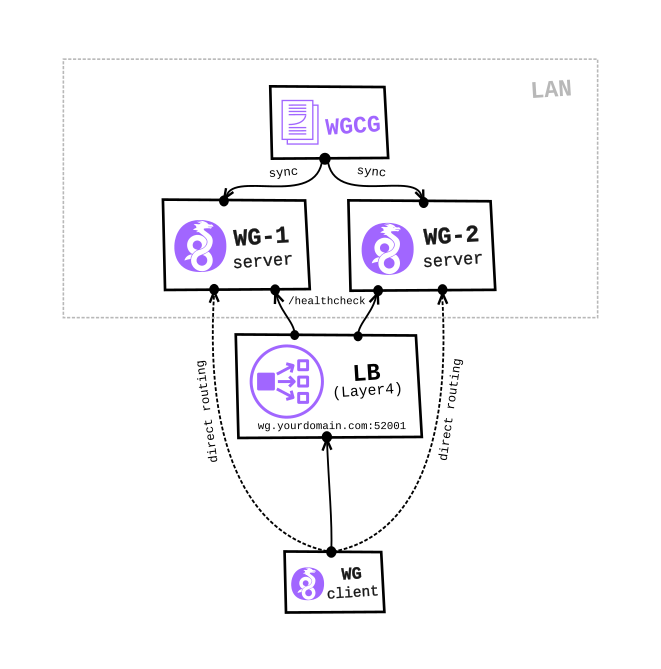Full documentation about manual Wireguard installation and configuration process can be found here.
This script is created to ease manual process of Wireguard configuration and will help you to automatically generate all the required configuration files (client and server), PKI key pairs and preshared key.
Arch
pacman -S wireguard-tools gnupg qrencode
yay grepcidrUbuntu
apt-get install wireguard-tools gpg qrencode grepcidrMacOS
brew install wireguard-tools gpg qrencode grepcidrMake sure to append following line to wgcg.conf file only if using MacOS.
By doing this we will force script to use GNU instead of BSD command line utilities (e.g. grep) and prevent any possible incompatibility issues.
echo -e '\n# Make sure script is using GNU command line utilities on MacOS\nexport PATH="/usr/local/opt/grep/libexec/gnubin:${PATH}"' >> wgcg.confBefore running the script we'll have to update wgcg.conf configuration file.
For most use cases the only variable we'd have to modify is WGCG_SERVER_PUBLIC_IP.
# Server name (wireguard interface name e.g. wg0 || wg1 || wg2)
WGCG_SERVER_NAME="wg0"
# HostMin to HostMax range can be used to assign IP addresses to WireGuard clients
# e.g. ./wgcg.sh -c foo 10.0.0.2
#
# Network: 10.0.0.0/22
# HostMin: 10.0.0.1
# HostMax: 10.0.3.254
# HostIDs: 1022
#
# WireGuard server private IP address (with optional CIDR - default: 22)
WGCG_SERVER_WG_IP="10.0.0.1"
# Static server port
WGCG_SERVER_PORT="52001"
# Server's public IP or FQDN
WGCG_SERVER_PUBLIC_IP="wg.yourdomain.com"
# SSH server IP address (default: ${WGCG_SERVER_PUBLIC_IP}) (optional)
# Note: This option can be used in case SSH server is listening on different IP address,
# if not specified, ${WGCG_SERVER_PUBLIC_IP} will be used instead
WGCG_SERVER_SSH_IP=""
# SSH server port (optional)
WGCG_SERVER_SSH_PORT="22"
# Space separated list of DNS IPs (default: 1.1.1.1 1.0.0.1) (optional)
WGCG_CLIENT_DNS_IPS="1.1.1.1 1.0.0.1"
# Space separated list of subnets (with CIDR) required for split-tunneling (default: 0.0.0.0/0) (optional)
WGCG_CLIENT_ALLOWED_IPS="0.0.0.0/0"
# All configuration and key files will be stored in this directory
WGCG_WORKING_DIR="${HOME}/wireguard/${WGCG_SERVER_NAME}"Copy wgcg.conf and wgfw.rules files to wgcg directory.
mkdir -p ${HOME}/wireguard/wgcg
cp wgcg.conf ${HOME}/wireguard/wgcg/
cp wgfw.rules ${HOME}/wireguard/wgcg/Copy wgcg.sh script to /usr/local/bin directory.
cp wgcg.sh /usr/local/bin/It is also possible to specify custom configuration file by passing WGCG_CONFIG_FILE environment variable.
WGCG_CONFIG_FILE="${HOME}/wireguard/wgcg/wgcg.conf" wgcg.shPrint help and current default options.
wgcg.sh -hOutput:
Usage:
wgcg.sh options
Options:
-P|--sysprep filename.sh Install WireGuard kernel module, required tools and scripts (will establish SSH connection with server)
-s|--add-server-config Generate server configuration
-c|--add-client-config client_name client_wg_ip Generate client configuration
-B|--add-clients-batch filename.csv[:rewrite|:norewrite] Generate configuration for multiple clients in batch mode
Supported action modes are 'rewrite' or 'norewrite' (default)
'rewrite' action mean regenerate ALL, 'norewrite' mean generate only configs and keys for new clients
-e|--encrypt-config client_name [passphrase] Encrypt configuration file by using symmetric encryption (if passphrase not specified it will be generated - RECOMMENDED)
-d|--decrypt-config client_name Decrypt configuration file and print it out on stdout
-r|--rm-client-config client_name Remove client configuration
-q|--gen-qr-code client_name [-] Generate QR code (PNG format) from client configuration file, if - is used, QR code will be printed out on stdout instead
-l|--list-used-ips List all clients IPs that are currently in use
-S|--sync Synchronize server configuration (will establish SSH connection with server)
-h|--help Show this help
Current default options:
WGCG_SERVER_NAME="wg0"
WGCG_SERVER_WG_IP="10.0.0.1"
WGCG_SERVER_PORT="52001"
WGCG_SERVER_PUBLIC_IP="wg.yourdomain.com"
WGCG_SERVER_SSH_PORT="22"
WGCG_CLIENT_DNS_IPS="1.1.1.1 1.0.0.1"
WGCG_CLIENT_ALLOWED_IPS="0.0.0.0/0"
WGCG_WORKING_DIR="/home/username/wireguard/wg0"
wgcg-install-wireguard.sh module will do all required system preparations on the WireGuard server (running the module is idempotent operation):
- Install
wireguardkernel module and tools - Load the module
- Generate
wgfw.shscript - Enable IP forwarding (routing)
Note: You have to run it only once!
wgcg.sh --sysprep modules/wgcg-install-wireguard.shGenerate server keys and config.
wgcg.sh -sGenerate client config, PKI key pairs and update server config (add new Peer block)
wgcg.sh -c foo 10.0.0.2or to generate multiple client configs at once, create client-configs.csv file
cat > client-configs.csv <<'EOF'
foo,10.0.0.2
bar,10.0.0.3
EOFand run.
wgcg.sh -B client-configs.csvBy default -B will only generate client config and key files for newly added clients, if you plan to regenerate config and key files for ALL clients that are specified in the csv file,
you'll have to use rewrite action mode, globally or per client line, in case both are specified last one has precedence.
Global rewrite action mode
wgcg.sh -B client-configs.csv:rewriteor per client line.
Note: It is also possible to protect individual client from regenerating config and key files by specifying norewrite action.
cat > client-configs.csv <<'EOF'
foo,10.0.0.2,rewrite
bar,10.0.0.3,norewrite
EOFRemove client config, PKI key pairs and update server config (remove Peer block).
wgcg.sh -r fooSynchronize local server configuration file with server (live update).
wgcg.sh --syncIn order to send client configuration file to a person safely, you can use GPG symmetric encryption to encrypt data before sending it, then you can send configuration file to a person via one channel (webwormhole) and passphrase via different channel (ots).
Encrypt configuration file.
wgcg.sh -e fooTo test passphrase just run decrypt command, if everything is OK client configuration will be printed out on the standard output.
wgcg.sh -d fooIt is also possible to manage multiple clusters with single script.
Create configuration file and command alias for every cluster.
Note: Append following lines to ~/.zshrc or ~/.bashrc file.
alias wgcg-office1.sh="WGCG_CONFIG_FILE=${HOME}/wireguard/wgcg/office1.conf wgcg.sh"
alias wgcg-office2.sh="WGCG_CONFIG_FILE=${HOME}/wireguard/wgcg/office2.conf wgcg.sh"source ~/.zshrc
# or
source ~/.bashrcwgcg-office1.sh -hCustom firewall rules, in iptables compatible format, can be added using wgfw.rules file. All rules from this file are going to be applied in idempotent manner on the server side at server startup time or each time wgcg.sh --sync command is executed.
It is also possible to run the script inside of Docker container with already preinstalled dependecies.
Build docker image.
docker build --no-cache --force-rm --build-arg USER=${USER} --build-arg UID=${UID} -t wgcg .Run the script.
./wgcg-docker.sh -hor if you are not using default configuration filename (wgcg.conf).
WGCG_CONFIG_FILE="${HOME}/wireguard/wgcg/wg0.conf" ./wgcg-docker.sh -h
